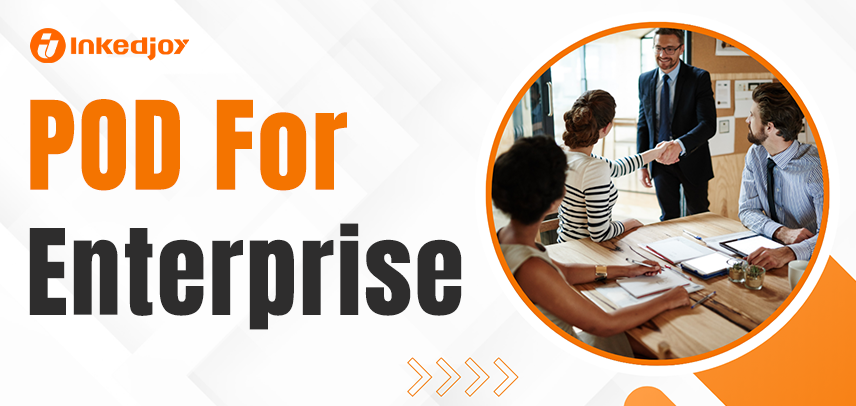
POD for Enterprise: Streamlining Custom Procurement
Print on Demand (POD) is a modern approach where businesses only print products when they get an order. It helps save on warehouse space, cuts down on risk, and lets businesses offer custom products without the big upfront costs. This model is perfect for small businesses or online store owners who want to focus on marketing and designing, while leaving the production, storage, and shipping to the POD platform.
POD vs. Traditional Wholesale Procurement
With the dynamic market of today, companies have to respond immediately to changing needs. Print on Demand is an economical, flexible solution as companies only print products after they are ordered. This contrasts with wholesale buying, where companies have to estimate needs way ahead of time and first purchase large orders.
Below, these strategies have been placed opposite each other based on supply chain flexibility, costs, and market responsiveness. To better understand how POD stacks up against traditional methods, here's a quick side-by-side comparison:
| Category | POD (Print on Demand) | Traditional Wholesale |
|---|---|---|
| Supply Chain Flexibility | Products are made to order, reducing inventory risk. Easy to adapt and scale. | Requires bulk purchasing in advance. Hard to adjust quickly to demand changes. |
| Cost & Cash Flow | No upfront inventory costs. Pay only after a sale. Better cash flow management. | High upfront costs. Capital tied up in stock and storage. Risk of unsold goods. |
| Market Adaptability | Quickly launch new designs and respond to trends. Test ideas with low risk. | Slow to react. Based on forecasts. May miss trends or be stuck with old stock. |
Now that we've seen the basic comparison, let's break down each point in more detail to see how they impact your business.
Supply Chain Flexibility
POD Model:
POD allows businesses to produce products as they sell, hence minimizing unsold stock risk. This makes production flexible, depending on the requirements of the customers, and is very useful for small businesses.
For example, there are sites like Inkedjoy that have over 1500 customizable products and business owners can have their own products customized without worrying about unsold stock. This allows small businesses to save costs initially as well as save on finances.
Traditional Wholesale Model:
Conventional wholesale trade, however, forces business owners to prebuy humongous quantities of commodities, which turn into useless dead stock if sales do not occur as forecasted.
It is impossible for business owners to change the quantity of production instantly; thus, they form the habit of hoarding, which immobilizes resources as well as capital. Business owners also risk being faced with either being understocked or overstocked, depending on sales forecasts.

Cost Control & Cash Flow
POD Model:
POD reduces the financial pressure on businesses by ensuring that companies only pay for products that have been sold. There are no upfront procurement costs for inventory, and production, storage, and shipping are managed by the POD platform, helping businesses optimize cash flow.
This system allows businesses to focus on growing their customer base and enhancing their products without worrying about inventory management costs.
Traditional Wholesale Model:
Conventional wholesale model agreements require upfront prepayment of large volumes of goods, and they can put business firms out of pocket significant amounts of money for storage as well as handling.
This model locks up capital, limiting companies' mobility to use resources elsewhere, for example, advertising or the development of creative products. Even where sales performance is below expectations, companies also risk unsold goods that cannot be easily sold back.
Market Adaptability
POD Model:
POD allows business organisations to respond rapidly to market trends and developments. As they produce based on orders, business organisations can easily change existing products because they can re-engineer new designs.
As they have design preview features, POD sites allow business organisations to have market-needs-fulfilling products even before they can initiate production of these products. This allows companies to be agile because they can respond rapidly to consumer reactions as well as market conditions.
Traditional Wholesale Model:
Traditional wholesale trade processes won't respond too quickly to fluctuating requirements. Company forecasting of future requirements is based on the use of historical sales data, which could cause companies to over- or under-order products.
As pre-ordered in quantities, product corporations can't respond very quickly, and companies can miss out on trending opportunities or have unsellable products as requirements change.
How to Evaluate and Choose the Right POD Platform: 5 Essentials for Success
Selecting the right POD platform is crucial for your business success. Here are the key factors to consider when evaluating platforms.
Platform Features and Support
Picking a POD platform isn't something you rush. Start with the basics—does it have the features you actually need? A good platform should make designing easy, handle orders automatically, and connect smoothly with your store. If it plays well with Shopify or Etsy, even better. The less you have to manage yourself, the more time you'll have to focus on your products.
Costs and Profitability Potential
Confirm each POD service price model to ensure that you understand what is most beneficial for your business. Take into consideration potential unknown costs like packaging or design costs. Having an idea of these costs ahead of time means that you can gauge your range of profit and receive better business insight.
Platform Flexibility
Go for POD platforms whose products and options can be diversely customized. This is because they can accommodate diverse market conditions as they change and diverse consumer needs. It is also because diversely customizable products and options diversify your products as you expand your business.
Stable and Scalable Supply Chain
- Reliability of Production and Shipping
Reliability is crucial for maintaining customer satisfaction. Evaluate the POD provider's ability to deliver products on time and with accuracy. A platform with a proven track record of timely deliveries ensures that your customers will receive their orders as promised.
- Global Supply Chain Management
For businesses that aim to expand internationally, it's important to choose a POD platform that supports global shipping. A robust logistics network allows your business to reach a broader customer base and meet international demand without the complexities of managing multiple vendors.
- Quality Control and Monitoring
To maintain consistent product quality, opt for a POD platform that offers quality control measures. Third-party quality checks or integrated monitoring systems ensure that every product meets the required standards, protecting your business reputation and customer trust.
3 Ways to Enhance Customer Experience and Loyalty through POD
To enhance customer loyalty and satisfaction, businesses should prioritize personalization, thoughtful packaging, and continuous improvement through customer feedback.
1. Customization and Personalization
POD platforms allow businesses to offer personalized products that cater to individual customer preferences. Personalized items, such as custom engravings or unique designs, not only enhance customer satisfaction but also build a stronger emotional connection with the brand. This level of customization can help drive repeat business and customer loyalty.
2. Packaging and Branding
Even packaging comes under the buyer experience. Providing customized packaging, such as custom boxes or custom gift cards, can assist in elevating the box-opening experience and perceived value of your products. Quality packaging fortifies your brand image and acts as motivation for enduring brand loyalty.
3. Customer Feedback and Improvement
Encouraging customer feedback allows businesses to continually refine their products and services. By actively listening to customers and making improvements based on their input, businesses can ensure that their offerings remain relevant and competitive while strengthening customer loyalty.
Conclusion: Transforming Enterprise Procurement through Strategic POD Implementation
Print on Demand (POD) is the ideal solution for companies to streamline processes, save costs of inventory, and sell customized products that meet market needs. Inkedjoy is one of those platforms where companies can concentrate on branding and marketing and procure production, storage, and delivery from secure POD vendors.
All set to streamline your custom procurement process for maximum process efficiency? Check out Inkedjoy today and enjoy custom procurement, hassle-free and inventory-free!



